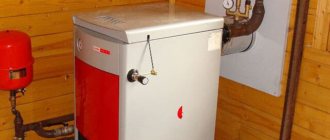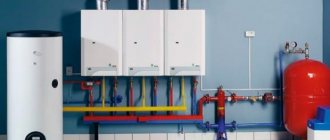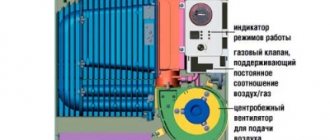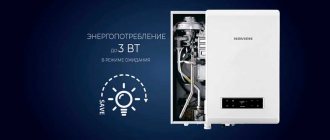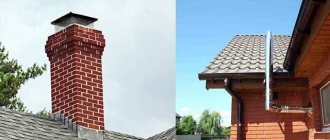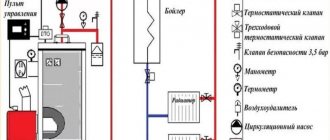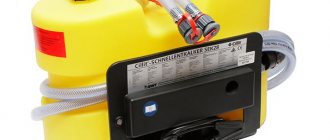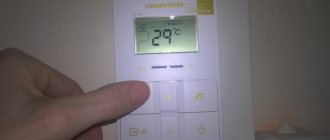At home, by definition, it should be warm. This can be achieved in a variety of ways. However, a prudent owner strives to do this as efficiently and economically as possible. Such options include installing a wall-mounted gas boiler. And this is quite justified, since gas heating is very profitable, and the equipment is quite simple to operate and install.
If you also started thinking about purchasing a wall-mounted heating boiler, then be sure to read our material. In it we will try to talk in as much detail as possible about the operating principles of such equipment and the types of wall-mounted devices. We will also consider all the nuances of connecting such a system.
The principle of operation of a wall-mounted gas boiler
The installation and connection of the heating device depends on its type. Therefore, you need to understand exactly how the device works and which of its varieties you will be dealing with.
Any wall-mounted gas boiler is a compact device, the maximum power of which is limited to 42 kW.
Wall-mounted gas boilers are powerful compact devices that provide the room with heat and hot water
The main elements of the system include:
- Gas burner . It supplies gas to the chamber where the combustion process occurs. With the help of nozzles, fuel is distributed as evenly as possible. Modern modulated burners can maintain a given temperature and regulate the flame strength.
- Heat exchanger through which the coolant moves. The best efficiency is for a copper device. In condensing boilers there may be two such elements.
- Expansion tank . Designed to compensate for excess water resulting from heating.
- Circulation pump . Powerful models may have two such elements.
- Boiler automation or a system of devices whose task is to maintain a set temperature in a heated room. May include devices powered by electricity or non-volatile.
- Devices that control and regulate the operation of the boiler.
- Fan . Only used in turbocharged models.
- Security system . Stops the boiler operation when dangerous situations occur.
Modern models are additionally equipped with self-diagnosis systems that can detect about 90% of boiler faults. The display shows the number of the diagnosed breakdown, which is promptly corrected by a service technician.
The figure shows a diagram of a double-circuit wall-mounted gas boiler with a closed combustion chamber
Two big differences
The boilers mentioned above are the extremes of a huge variety of models of gas water heating devices. They are available for self-installation. Any other gas heating boiler requires professional work for installation. However, every cloud has a silver lining - specialized companies also take on the preparation of the premises and the preparation of documents. But why can you install only the “tips of scissors” yourself?
Simple water heater
The simplest boiler is really very simple: a gas burner, a heat exchanger - that's all. It is enough to connect water and gas to it, vent the exhaust into the chimney - and you can use it. If the papers have already been completed; otherwise - an inevitable large fine.
Home boiler room
A double-circuit boiler with a boiler and full automation is so “smart” that installing it is as easy as the simplest one. Automation is important not only for simplicity: a complete system with a double thermostat and a microprocessor monitors the temperature in the house and outside, according to a given program, reduces heating to a minimum according to sanitary standards when no one is at home (for example, when everyone is at work). The gas consumption of such a boiler is 30-70% less than with manual or semi-automatic adjustment, and the savings are greater the more severe the weather.
But such a home boiler room has a serious drawback: if you find yourself in a natural disaster zone and the power supply is disrupted, the automation “stalls” and the boiler goes into the mode of minimal heating of the room. Therefore, such a boiler requires additional costs for guaranteed power supply. It is not difficult to provide it yourself, see below.
Types of wall devices
According to their functional purpose, gas heating units are divided into two groups:
- Single-circuit. Intended for heating only. They are connected to the heating circuit and heat the coolant. The organization of hot water supply in this case is carried out by installing an electric or gas water heater of any type.
- Dual-circuit. They heat the room and provide hot water. An additional circuit for heating water is built into the boiler. The technological feature of the device is that it is impossible to simultaneously heat water and heat the room.
The priority action of dual-circuit units is to heat the water; heating operation stops at this time. Considering that water can be heated quickly, the boiler heats the building quite effectively.
If the tasks of the gas unit are planned to include both heating the coolant and supplying hot water, then it is better to purchase a double-circuit boiler. They come with one or two heat exchangers. When equipped with two, two circuits can be served simultaneously
According to the method of fuel combustion, all devices are divided into the following two groups.
Group #1 - devices with an open combustion chamber
Such devices are also called natural draft heating devices. They take the oxygen necessary for combustion from the room in which the device is located.
To remove combustion products, they need a traditional type chimney. Thus, a mandatory requirement for installing such a boiler is the provision of good ventilation.
If the heating device is installed in a residential area, it must be equipped with high-performance supply ventilation.
The best option for installing a heating device with an open firebox is the presence of a separate room, the so-called firebox, where it is placed.
Systems with natural ventilation are quite popular due to their low cost and energy independence.
The figure schematically shows boilers with open and closed type burners
Group #2 - devices with a closed combustion chamber
Turbocharged devices are equipped with a closed combustion chamber. They take the air, without which the combustion process is impossible, from the street. For this purpose, the devices are equipped with coaxial type chimneys.
Such a chimney is made in the form of a structure of two pipes, one of which is nested inside the other. The combustion products are discharged outside through the inner pipe.
At the same time, street air flows in the opposite direction through the gap between the two pipes. It is clear that boilers with a closed firebox do not in any way affect the composition of the indoor air, which makes it possible to install them even in living rooms.
In this case, it is necessary to equip a coaxial chimney system, which is higher cost and more complex installation compared to a separate traditional chimney.
Chimney issue
As mentioned above, the chimney must be led outside through the wall or connected to a common one. If you do not equip it with a cap, air, water, debris, and foreign objects will get in there, which will inevitably lead to clogging of all devices connected to it. Even if the boilers connected to the system are in full working order, a clogged or dirty chimney will affect the quality of heating. What other reasons can there be for a boiler to not work? Read here.
Is it possible to install it yourself?
You can install a wall-mounted gas boiler with the simplest modifications with your own hands. Such, for example, as single-circuit devices with an open combustion chamber.
To install them, you will need to connect the heating system, supply gas and organize a chimney. However, some boiler manufacturers indicate in the technical documentation for their products that installation should only be carried out by specialists.
Installing and connecting a gas boiler is a responsible and quite complicated job. Many heating equipment manufacturers require that this be done by professionals.
In this case, independent installation of even the simplest models is prohibited. Thus, if you plan to install the equipment yourself, you should make sure that the manufacturer allows this before purchasing it.
Checking the correct installation and connecting the device to the gas main should only be carried out by a specialist with special permission.
In addition, the gas service representative must issue a permit to operate the installed equipment. Without this, the owner of a self-installed and running device will face serious fines.
Thus, without inviting specialists, you can only connect the device to the heating system and to the water supply. Moreover, it is advisable to do this only if you have some experience.
Wall-mounted gas boilers are installed in autonomous forced-type heating circuits with natural coolant circulation
Boiler room requirements
Gas equipment belongs to the category of explosion and fire hazards. Therefore, special requirements are imposed on the room in which it will be installed.
First of all, it must have natural light. In this case, for each cubic meter of room there should be at least 0.03 square meters. m of window opening without frame, that is, only glazing. The window must be equipped with a window.
The wall on which the gas boiler is installed must be finished with non-combustible materials
Another prerequisite is the presence of supply ventilation, which can ensure a change in the air volume of the room within 3 times in one hour. In this way, gas pollution in the room can be minimized.
In addition, the volume of the room in which it will be installed depends on the power of the selected boiler. Equipment with a power of 30 kW and below can be placed in 7.5 cubic meters. m boiler room.
Image gallery
Photo from
Wall-mounted gas unit in the kitchen
Separate room for the location of the unit
Wall-mounted gas boiler in the bathroom
Correctly installed unit
For heating devices whose power varies from 30 to 60 kW, you will need a combustion chamber with a volume of 13.5 cubic meters. m and above. If the heating device is to be placed in an apartment, it is usually installed in the kitchen.
This is possible if all the requirements of SNiPs are met. An important nuance: in this case, the total thermal power from all heating devices in the kitchen should not exceed 150 kW.
According to the standards for installing wall-mounted gas boilers, to improve air exchange in the kitchen door, it is necessary to make a hole with an area of at least 0.02 square meters and cover it with a grill.
Experts recommend for installation in an apartment building only equipment with a closed firebox, equipped with a coaxial chimney. In kitchens with a volume of 7.5 cubic meters. m or less, it is prohibited to install more than one heating device.
Requirements for the installation of gas heating equipment are regulated by SP-41-104-2000 and SNiP 42-01-2002. Compliance with installation standards guarantees safe operation
In private houses, it is recommended to allocate a room for gas boilers, separated from the living rooms by fire-resistant, durable partitions.
It is optimal that the materials used to decorate the room have a fire resistance time limit of at least 45 minutes. It is desirable that the layout of the premises prevents the rapid spread of flames to living rooms.
The gas boiler can only be secured to a solid base. Partitions made of plywood or plasterboard are not suitable for these purposes. The wall on which the heating device will be placed must be finished with fire-resistant materials.
If this is not the case, a non-combustible substrate is installed under the boiler. The minimum distance from the device to supporting structures is 0.5 m to the ceiling or walls and 0.8 m to the floor.
The photo shows one of the options for connecting a wall-mounted gas boiler
Step-by-step installation of equipment
Before installation, you need to unpack the new boiler and check the completeness of the delivery. The availability of parts is checked according to the operating instructions, which must be included with the device.
If any item is missing, please contact the supplier immediately. One more nuance. The boiler must have an ideal appearance without dents, chips or signs of repairs. If this is not the case, you need to call the sellers.
It is important to make sure that the technical data specified in the technical data sheet of the heating device exactly matches those printed on the device itself. In addition, they must correspond to the numbers specified in the operating instructions for the device.
Immediately before starting installation, you need to flush the boiler pipes, which may contain various debris that got inside during the manufacture of the device and its transportation.
Installing a gas boiler involves connecting heating pipes, water supply and gas mains, as well as installing a chimney
It is also advisable to flush the heating system lines. After the preparation is completed, you can begin installation.
The specifics and procedure for its implementation are determined by the characteristics of the equipment: the number of circuits involved and the type of combustion chamber.
Most often, double-circuit appliances with a closed firebox are installed in houses. Let's take a closer look at the installation of just such a modification.
Stage #1 - preparing the wall mount
To secure gas boilers, a special bracket is used, which should be included in the delivery of the device. Reliable fasteners are used for mounting it on the wall. They should be selected according to the material from which the wall is made.
It is quite possible that those that the manufacturer packaged with the heating device will not be suitable. Then you will need to choose and purchase others.
The purpose of the bracket is to support the weight of the boiler and additional equipment, as well as to provide it with an even, clearly aligned position without distortion.
To accurately mark the wall, you can use a paper stencil, which usually comes with the boiler. With its help, you can easily mark holes for fasteners.
Once this is done, the bracket is secured in place and the boiler is hung onto it.
Heating pipes are connected to the corresponding pipes of the gas equipment. You can determine their location from a photograph.
Stage #2 - connecting the heating system pipes
Depending on the type of heating system, and it can be single-pipe or two-pipe, the number of pipes connected to the boiler may vary. In any case, we start by removing the plugs from the device’s pipes.
To protect the boiler from the ingress of dirt particles from the heating line, it is recommended to install a mesh filter at the return inlet.
If the water in the system is hard or in other respects does not meet the requirements stated by the heating device manufacturer, you should take care of installing additional treatment equipment.
These could be, for example, polyphosphate dispensers. If this is not done, the device will quickly break down. All connections must be made in compliance with all rules and regulations.
Sealing is required. For this purpose, special sealants are used: traditional paint or tow, or modern thread sealants. In addition, experts recommend the mandatory installation of shut-off valves for supply and return.
This is necessary to facilitate repair of the boiler if it fails. In addition, the fittings will help prevent possible airing of the radiators.
A water filter is an element that must be installed when connecting a gas boiler to a water circuit
Stage #3 - connection to the water circuit
This work is almost the same as connecting heating pipes. The main difference is the taps used and the diameter of the pipes.
The cold water supply must be equipped with a filter, which will eliminate the possibility of contaminant particles entering the heating device. Otherwise the equipment will be damaged.
The taps used to isolate the boiler from the water supply must have detachable connections.
Such models are also called “American”. They significantly simplify installation, and in case of unforeseen situations, they make it possible to quickly replace a worn-out faucet.
It must be remembered that the pipes supplying cold water are located on the heating device on the left side relative to the center, and those supplying hot water are located on the right.
Stage #4 - connection to the gas main
This part of the work should only be carried out by a qualified specialist, since the cost of an error can be very high. In any case, upon completion of the connection, its correctness must be checked by a representative of the gas service. He will also conduct the first start-up of the equipment.
All operations when carrying out work independently must be performed with the utmost care. They start by connecting the branch of the gas main with the corresponding pipe on the boiler.
When connecting the boiler to the gas main, you can only use tow to seal the threaded connection, otherwise it will not be possible to achieve the required tightness
A special filter must be installed on the tap that cuts off the gas supply from the main line. Experts strongly recommend not to skimp on this detail.
A cheap, low-quality filter will not work for long, which can cause the gas boiler to fail. When arranging a connection, special attention should be paid to its sealing.
You must understand that the weight of gas is much less than air, and if the connection is not tight enough, it will leak out of the pipeline. The consequences can be the most dire. Therefore, careful sealing is mandatory.
The main materials for sealing a threaded connection are paint and tow; the use of sealants such as fum tape is unacceptable.
A special flexible connection is installed after the filtration element. You need to know that using rubber hoses for its installation is strictly prohibited.
This is due to the fact that over time, the material from which the part is made dries out and becomes covered with cracks through which gas begins to leak. Therefore, the best choice for arranging such a connection is a corrugated hose.
A corrugated hose is a good choice for connecting the device to the gas main. It is quite strong, durable and does not collapse under the influence of gas
For its manufacture, high-quality durable stainless steel is used. This is a very strong and durable material, particularly resistant to high humidity and the adverse effects of gas.
The hose is secured to the heating device pipe using a union nut. In this case, a paranitic gasket must be used, which provides the necessary sealing of the connection.
Stage #5 - connecting to the electrical network
This operation is only necessary for appliances with a closed firebox that require electricity. It powers the fan that removes combustion products and the automation that controls the system.
Typically a standard three-wire connection diagram is used. Experts recommend connecting the boiler to the network only through a stabilizer, which will make it possible to avoid power surges and thereby extend the life of the boiler.
If you live in an area where there are frequent power outages, then it is additionally advisable to purchase an uninterruptible power supply - this will protect your equipment from sudden power surges
Stage #6 - arrangement of the chimney outlet
The easiest way is to connect a heating device with a closed firebox to the chimney. For them, special coaxial pipes are used. In apartment buildings, the boiler must be connected to the collective chimney.
In individual buildings, a coaxial type chimney is led out to the street through a wall. The height of the pipe suspension in this case is not particularly important, since the necessary draft is created by the built-in fan.
Appliances with an open firebox must be connected to an individual chimney. The boiler is connected to it by a pipe of the required cross-section.
The material for its manufacture is selected so that the part is resistant to combustion products, high temperature and mechanical wear.
You can check the tightness of the gas pipe connections using a soap solution. A gas leak will manifest itself as bubbles
Before starting work, you need to make sure that there are no soot residues, installation debris, etc. in the chimney. When installing a chimney pipe, it should be positioned with a slight slope towards the gas boiler.
A vertical section of pipe is installed at the outlet of the device; its length before turning must be equal to at least two pipe diameters. The total length of the connection section to the chimney should be minimal.
Stage #7 - preparation for the first launch
Before the test run, the heating system is filled with water. The liquid is pumped until a pressure of 2 atmospheres is reached. Pumping water is carried out as slowly as possible in order to remove the maximum amount of air collected inside.
In addition, the system is checked for leaks. All leaking connections must be sealed immediately.
To identify insufficiently tight connections on the gas main, you need to dilute a soap solution and lubricate all connections with it. Then watch.
Air bubbles will appear in poor quality areas. Any faults found should be corrected and re-checked. The first start-up of the equipment should be carried out only in the presence of a gas service representative.
Electricity
The internal automation of the equipment does not require much power. However, the rules require the installation of a separate power line containing a circuit breaker with a rating of 20A. A computer uninterruptible power supply is quite suitable as a backup power supply during a power outage. For example, with a power of 1 kW it can keep the boiler in working condition for up to 1 day. This time is usually enough to restore power.


